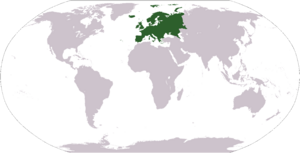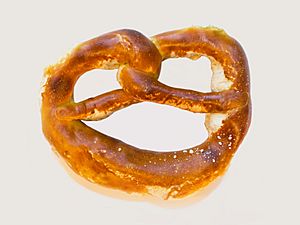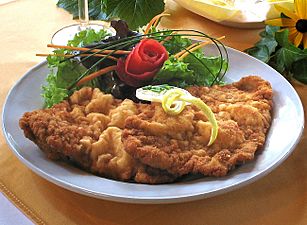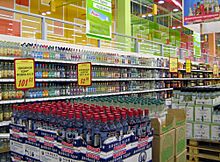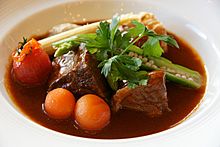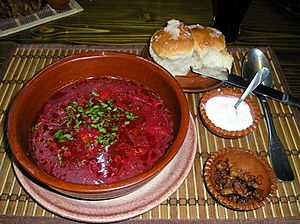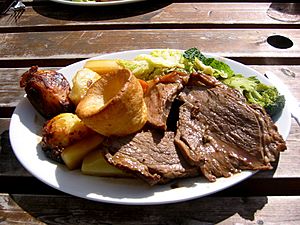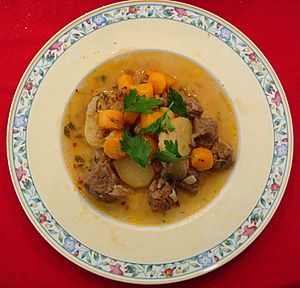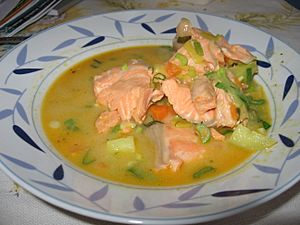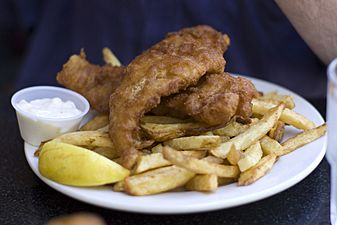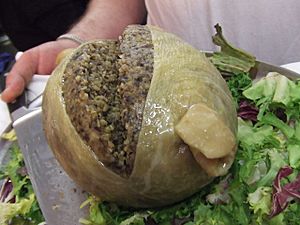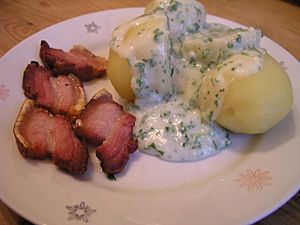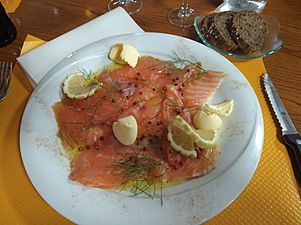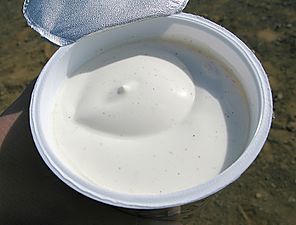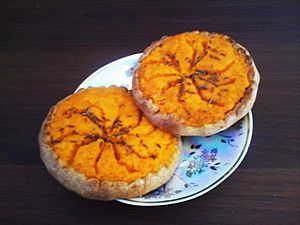List of European cuisines facts for kids
This article is about the many different cooking styles and food traditions found across Europe. A cuisine is a special way of cooking and preparing food that often belongs to a certain culture or country. European cuisine includes all the different foods from countries in Europe. It also includes foods from places like North America, Australia, and Latin America. This is because European settlers brought their cooking styles there.
The foods of European countries are very different from each other. However, they share some common features that make them stand out from Asian cuisines. For example, in European cooking, meat is often a main part of the meal. Bread made from wheat flour has been a common food for a long time. Other popular foods include pasta, dumplings, and pastries. After Europeans explored the Americas, the potato also became a very important food in Europe.
Contents
Central European Foods
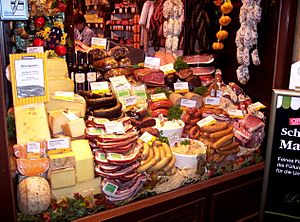
- Austrian cuisine comes from Austria. It has been influenced by foods from nearby countries. These include Italy, Hungary, Germany, and the Balkans. This mix of styles became very popular across the old Austro-Hungarian Empire.
-
- Austrian wine
- Viennese cuisine
- Czech cuisine has both influenced and been influenced by its neighbors. Many popular cakes and pastries in Central Europe first came from the Czech lands. Czech food often focuses on meat dishes. Pork is very common, and beef and chicken are also popular.
-
- Czech wine
- Hungarian cuisine is the traditional food of Hungary. Hungarian dishes often use meats, seasonal vegetables, fruits, fresh bread, cheeses, and honey. Their recipes are based on cooking traditions that are hundreds of years old.
-
- Hungarian wine
- Goulash is a famous Hungarian stew.
- Polish cuisine is the food of Poland. Traditional Polish dishes use meats, vegetables, fruits, breads, cheeses, and sausages. Common ingredients include sauerkraut, paprika, beetroot, and sour cream. Herbs like marjoram, dill, and caraway seeds add flavor. Cakes and pastries are favorite desserts.
-
- Polish wine
- Pierogi are popular Polish dumplings.
- Slovak cuisine changes a bit from one region to another. It was influenced by the foods of nearby countries. Traditional Slovak food depended on what people could grow or raise themselves. This included wheat, potatoes, milk, pork, sauerkraut, and onions.
-
- Slovak wine
- Slovenian cuisine is very diverse because of the country's varied landscape and climate. Slovenia is bordered by Italy, Austria, Hungary, and Croatia. This means its food has been influenced by these different national cuisines.
-
- Slovenian wine
-
- Swiss wine
- Central European foods and dishes
-
Swiss cuisine – paprika sausage with potatoes at the Zeughauskeller, Zürich, Switzerland
-
Pretzels are especially common in Southern Germany.
Eastern European Foods
- Cuisines of Eastern Europe
-
- Belarusian cuisine is similar to other Eastern and Northern European foods. It mainly uses meat and various vegetables common in the region.
-
- Bulgarian cuisine is part of the food traditions of Southeastern Europe. It shares features with other Balkan foods. Bulgaria's warm climate and varied land allow many vegetables, herbs, and fruits to grow well. This makes Bulgarian food very diverse.
-
- Bulgarian wine
- Moldovan cuisine uses many grapes, fruits, vegetables, grains, meat, and milk products. Moldova has very fertile soil. This allows people to grow a wide range of natural foods.
-
- Moldovan wine
- Romanian cuisine is a mix of different food traditions. It has been greatly influenced by Ottoman (Turkish) cooking. However, it still keeps its own unique character.
-
- Romanian wine
- Russian cuisine is very diverse because Russia is the largest country in the world. From the 16th to 18th centuries, Russia's growth brought new foods and cooking methods. Smoked meats and fish, pastries, salads, chocolate, and ice cream became popular. These new foods were mixed with traditional Russian dishes.
-
-
- Russian wine
-
-
- Ukrainian cuisine is very diverse. It has been influenced by Russian, Turkish, and Polish foods. Common ingredients include meats, vegetables, mushrooms, fruits, and herbs. Bread is a very important food in Ukraine. There are many different types of bread. Ukraine is sometimes called the "breadbasket of Europe."
-
- Crimean Tatar cuisine is mainly the food of the Crimean Tatars. They live on the Crimean Peninsula in Ukraine. Their traditional food is similar to that of the Volga Tatars. However, they do not eat horse meat. They also do not drink mare's milk.
- Ukrainian wine
- Caucasian cuisine – foods from The Caucasus region.
-
- Armenian cuisine includes the foods and cooking methods of the Armenian people. The food shows the history and geography of where Armenians have lived. It also includes influences from other cultures. The cuisine uses traditional crops and animals raised in Armenian areas.
-
- Armenian wine
- Azerbaijani cuisine is the food of Azerbaijan. Over centuries, it has been influenced by many different cultures. Azerbaijan has nine of the world's eleven climate zones. This helps the land be very fertile, which leads to a rich variety of foods.
- Georgian cuisine refers to the cooking styles and dishes from the country of Georgia. Georgian food is unique to the country. However, it also has some influences from Middle Eastern and European cooking.
-
- Georgian wine
Northern European Foods
- Baltic cuisines
- Cuisines of the Islands of the North Atlantic (IONA)
-
- British cuisine is the cooking traditions of the United Kingdom. British food is often described as simple dishes made with good local ingredients. It uses simple sauces to bring out the flavor. British cuisine has also taken in influences from people who have settled in Britain. This has created mixed dishes, like the Anglo-Indian chicken tikka masala.
-
- Scottish cuisine is the cooking traditions of Scotland. It has its own unique dishes and features. However, it shares a lot with wider European food. Scotland has many natural foods like game, dairy, fish, fruit, and vegetables. These are key to traditional Scottish cooking.
- Welsh cuisine
- Wine from the United Kingdom
- Regional foods
- Nordic cuisines
-
-
- Swedish wine
-
- Northern European foods and dishes
-
Fish and chips is an English dish of fried fish in crispy batter served with chips.
-
Stegt flæsk is a Danish national dish of fried pork belly generally served with potatoes and parsley sauce (persillesovs).
Southern European Foods

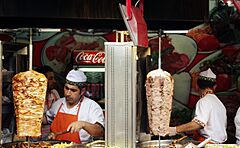
-
- Albanian cuisine is influenced by Turkish, Greek, and Italian foods. Each region in Albania has its own special dishes. Albanian food uses many Mediterranean herbs like oregano, black pepper, and rosemary for cooking meat and fish.
-
- Croatian wine
-
-
- Greek wine
- Regional foods
-
- Taramosalata, a Greek dip made with salted fish roe.
-
- Montenegrin wine
-
- Serbian wine
-
- Cuisines of the Iberian Peninsula
-
-
- Portuguese wine
- Spanish cuisine has many different dishes. These come from Spain's long history with many cultural influences. The food is also shaped by the country's geography and climate. It is heavily influenced by seafood from the waters around the country. Spanish wine is a big part of Spanish food.
-
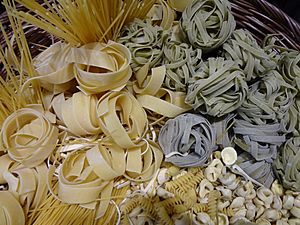
- Cuisines of the Italian Peninsula
-
- Italian cuisine is famous for dishes like pizza, pasta, lasagne, and Mozzarella. Italian food has been influenced by ancient Greek, Roman, and Etruscan cooking. It dates back to the 4th century BCE. Italian cuisine has strong regional differences. This is because of Italy's history and different climates. Most dishes are simple to make and not expensive. This is one reason why Italian food is so popular worldwide.
-
- Italian wine
- Regional Cuisines – In Italian cooking, each area has its own specialties. These differences come from nearby countries like France or Austria. They also depend on whether a region is near the sea or mountains. Italian cuisine also uses fresh, seasonal ingredients.
-
-
-
- Abruzzese
- Calabrian
- Emilia-Romagnan
- Roman
- Ligurian
- Lombard
- Neapolitan cuisine, Campanian
- Piedmontese
- Pugliese
- Sardinian
- Sicilian cuisine
- Tuscan cuisine
- Venetian cuisine
-
-
-
- Mediterranean diet
- Cypriot cuisine is the food of Cyprus. It is a mix of Greek and Turkish cooking styles.
-
- Cypriot wine
- Turkish cuisine is mostly based on Ottoman cuisine. Ottoman food was a blend of Central Asian, Middle Eastern, Eastern European, Armenian, and Balkan foods.
-
- Turkish wine
- Southern European foods and dishes
-
A variety of tapas: appetizers or snacks in Spanish cuisine
-
Mediterranean cuisine in Dalmatia, Croatia
-
Pizza is a Neapolitan dish and one of the world's most popular fast foods.
-
Gyros are a Greek dish of meat cooked on a vertical rotisserie.
Western European Foods
-
- French regional cuisine is known for being very diverse. Each region of France traditionally has its own special food. French cooking styles include nouvelle cuisine (new cooking) and haute cuisine (high cooking). In 2010, UNESCO added French gastronomy to its list of "intangible cultural heritage".
- French wine
-
- Luxembourg wine
- Western European foods and dishes
-
Bouneschlupp is a traditional Luxembourgish green bean soup with potatoes, bacon, and onions.
-
Pot-au-feu is a French dish of slowly boiled meat, typically beef, and vegetables.
-
Moules-frites is a Belgian dish of mussels and fries.
Regional and Historical Cuisines
- Regional Dutch cuisines can be found in three main areas of the Netherlands. These are the northeastern, western, and southern regions.
- German regional cuisine can be divided into areas like Bavarian cuisine (Southern Germany) and Lower Saxon cuisine (Northern Germany).
- The Alpine cuisine is found throughout the entire Alpine region. It is known for its simple, hearty foods. These foods were developed from the isolated life in mountain villages and huts.
- Regional cuisines of medieval Europe were different across the continent. This was due to climate, seasonal food changes, how areas were governed, and religious customs.
See also


